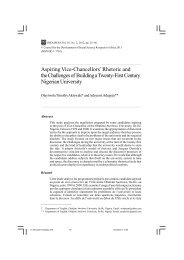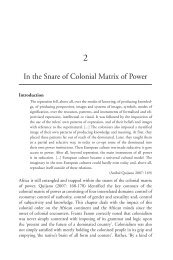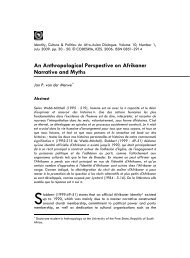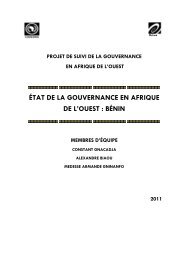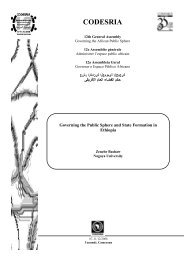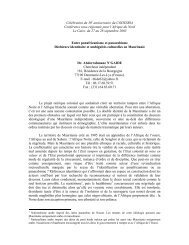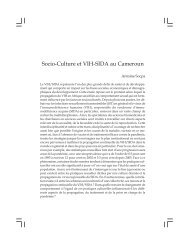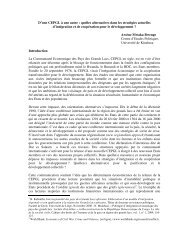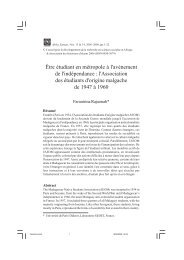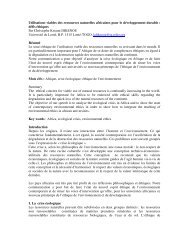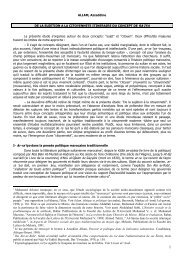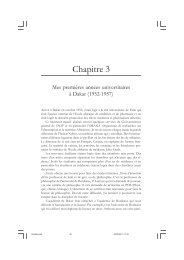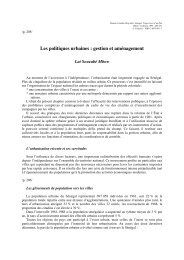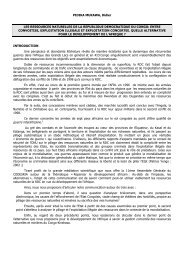Land and Agrarian Reform in Former Settler Colonial ... - codesria
Land and Agrarian Reform in Former Settler Colonial ... - codesria
Land and Agrarian Reform in Former Settler Colonial ... - codesria
You also want an ePaper? Increase the reach of your titles
YUMPU automatically turns print PDFs into web optimized ePapers that Google loves.
Murisa: Social Organisation <strong>in</strong> the Aftermath of ‘Fast Track’<br />
275<br />
Jo<strong>in</strong>t use of productive <strong>in</strong>frastructure<br />
The l<strong>and</strong> redistribution process was implemented <strong>in</strong> such a way that it<br />
brought together strangers from different backgrounds, such as Communal<br />
Areas, urban areas <strong>and</strong> former Large-Scale Commercial Farms, to settle on<br />
previously large-scale farms that had been subdivided <strong>in</strong>to smaller units for<br />
the l<strong>and</strong> beneficiaries (Murisa 2009; Murisa 2011: 1146). Most of these<br />
previously large farms had immovable productive assets such as tobacco<br />
barns, dip-tanks, cattle- h<strong>and</strong>l<strong>in</strong>g facilities <strong>and</strong> irrigation equipment <strong>and</strong> nonproductive<br />
or social assets such as farmhouses <strong>and</strong> farm worker compounds<br />
(GoZ 2001: 3) that could not be utilised effectively by a s<strong>in</strong>gle household<br />
resettled on 6 hectares of l<strong>and</strong>. As part of its efforts to rationalise access to<br />
such equipment, the GoZ issued a directive that all A1 households should<br />
share the productive <strong>and</strong> social <strong>in</strong>frastructure left beh<strong>in</strong>d by the previous<br />
owner, but did not clarify how this would be done (GoZ 2001: 2). The farm<br />
divisions <strong>in</strong> A1 areas created common graz<strong>in</strong>g l<strong>and</strong>s which had to be utilised<br />
by the resettled beneficiaries on a particular former Large-Scale Commercial<br />
Farm, thereby suggest<strong>in</strong>g another need for mechanisms of engagement <strong>and</strong><br />
cooperation among the beneficiaries.<br />
The Government of Zimbabwe policy on social <strong>in</strong>frastructure <strong>in</strong>herited<br />
from the previous owners <strong>in</strong> A1 areas was that it became state property to be<br />
used for state-specified public purposes, such as conversion of farm houses <strong>in</strong>to<br />
schools or cl<strong>in</strong>ics, while productive facilities were to be used on a shared basis.<br />
This policy, <strong>in</strong> some cases, provided an impetus towards the establishment<br />
of social structures to coord<strong>in</strong>ate the use <strong>and</strong> ma<strong>in</strong>tenance of these facilities<br />
(Murisa 2007: 39). With<strong>in</strong> the A2 scheme, the lease agreement provided the<br />
holder of the farm on which <strong>in</strong>frastructure was currently <strong>in</strong>stalled the authority<br />
to ‘use <strong>and</strong> to sublet <strong>in</strong>frastructure to other farmers <strong>and</strong> obliges them to grant<br />
such subtenants right of access to the <strong>in</strong>frastructure’ (World Bank 2006: 24).<br />
Evidence gathered from the field showed that slightly more than half of<br />
the population (52.3%) of the total sample had entered <strong>in</strong>to an arrangement<br />
of shar<strong>in</strong>g productive <strong>in</strong>frastructure (Table 7.4), with the phenomenon of<br />
shar<strong>in</strong>g be<strong>in</strong>g most common <strong>in</strong> Mangwe (71.7%) <strong>and</strong> Kwekwe (62.9%). The<br />
<strong>in</strong>frastructure that they shared <strong>in</strong>cluded tobacco barns, irrigation equipment,<br />
farm compounds, dams, cattle-h<strong>and</strong>l<strong>in</strong>g facilities <strong>and</strong> dip-tanks. 27 The <strong>in</strong>itial<br />
stages of resettlement were characterised by v<strong>and</strong>alism <strong>and</strong> loot<strong>in</strong>g of productive<br />
assets from the farms, while equipment such as tobacco barns rema<strong>in</strong>ed mostly<br />
unused <strong>in</strong> A1 areas, due to the changes <strong>in</strong> l<strong>and</strong> use patterns. Soon after the Fast<br />
Track <strong>L<strong>and</strong></strong> <strong>Reform</strong> <strong>in</strong> certa<strong>in</strong> localities, the shar<strong>in</strong>g of <strong>in</strong>frastructure was done<br />
<strong>L<strong>and</strong></strong> <strong>and</strong> <strong>Agrarian</strong> <strong>Reform</strong> <strong>in</strong> <strong>Former</strong> <strong>Settler</strong> <strong>Colonial</strong> Zimbabwe.<strong>in</strong>dd 275 28/03/2013 12:57:31



